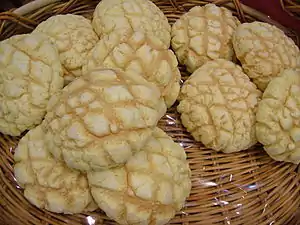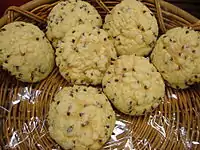Melonpan
A melonpan (メロンパン, meronpan) (also known as melon pan, melon bun or melon bread) is a type of Japanese sweetbun that is well known across the country and widely popular throughout China and Taiwan. The sweetbun is made from an enriched dough covered in a thin layer of crisp cookie dough. Their appearance resembles a melon, such as a rock melon (cantaloupe). They are not traditionally melon flavored,[1] but in recent times it has become popular for manufacturers to add melon flavoring to melon bread. Variations exist, including some with a few chocolate chips between the cookie layer and the enriched dough layer, and non-melon versions flavored with caramel, maple syrup, chocolate, or other flavors, sometimes with syrup, whipped or flavored cream, or custard as a filling. In the case of such variations, the name may drop the word "melon", instead replacing it with the name of the contents (such as "maple pan" for a maple syrup flavored bread) or may keep it despite the lack of melon flavor (such as "chocolate melon pan").
 | |
| Alternative names |
|
|---|---|
| Type | Sweet bun |
| Place of origin | Japan |
| Region or state | East Asia |
| Main ingredients | |
The name has a dual etymology, since "melon" is a loan word from English, while "pan"[2] is from the Portuguese word for bread.
In parts of the Kansai, Chūgoku, and Shikoku regions, a variation with a radiating line pattern is called "sunrise", and many residents of these regions call even the cross-hatched melon pan "sunrise".[3]
Melonpan and pineapple bun from Hong Kong are very similar. By comparison, the Japanese style is lighter in weight and taste, slightly drier and has a firmer outer layer (including top cookie crust) which resists flaking, unlike its Hong Kong counterpart, whose top cookie crust tends to flake easily. The Hong Kong version is also moister, and is generally soft on the outside and inside, with a stronger butter flavour.
History
After World War I, Okura Kihachiro brought an Armenian baker, Hovhannes Ghevenian, also known as Ivan Sagoyan, to Tokyo. Sagoyan worked at the Imperial Hotel in Tokyo and invented melonpan.[4][5]
Gallery
 Homemade melon buns
Homemade melon buns Melonpan variety containing chocolate chips
Melonpan variety containing chocolate chips.jpg.webp) Jumbo Melonpan for sale in Asakusa
Jumbo Melonpan for sale in Asakusa
See also
References
- Kazuko, Emi: Japanese Food and Cooking
- See Infoseek Japanese-English dictionary for pan/パン and Japanese words of Portuguese origin
- "'Melon Pan'/'Sunrise' Dialect Survey Map from Nikkei". Archived from the original on 2007-10-12. Retrieved 2007-04-04.
- Bakhchinyan, Artsvi (3 October 2019). "The Armenian Who Invented the Japanese Sweet Bun". The Armenian Mirror-Spectator. Retrieved 10 June 2021.
- Bakkalian, Nyri (2021-09-21). "Melonpan: The Japan Sweet Bread's Armenian History". Unseen Japan. Retrieved 2023-07-27.
